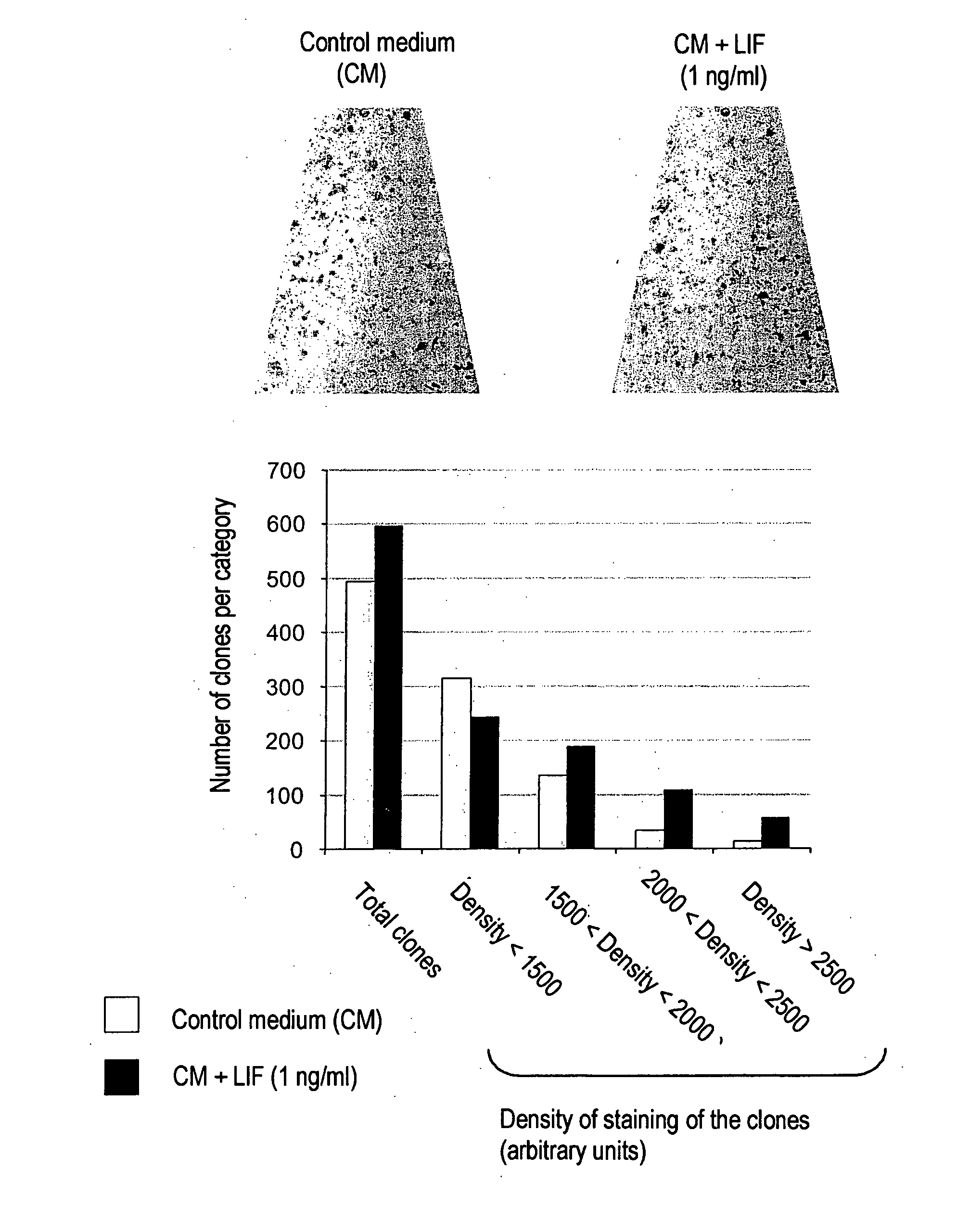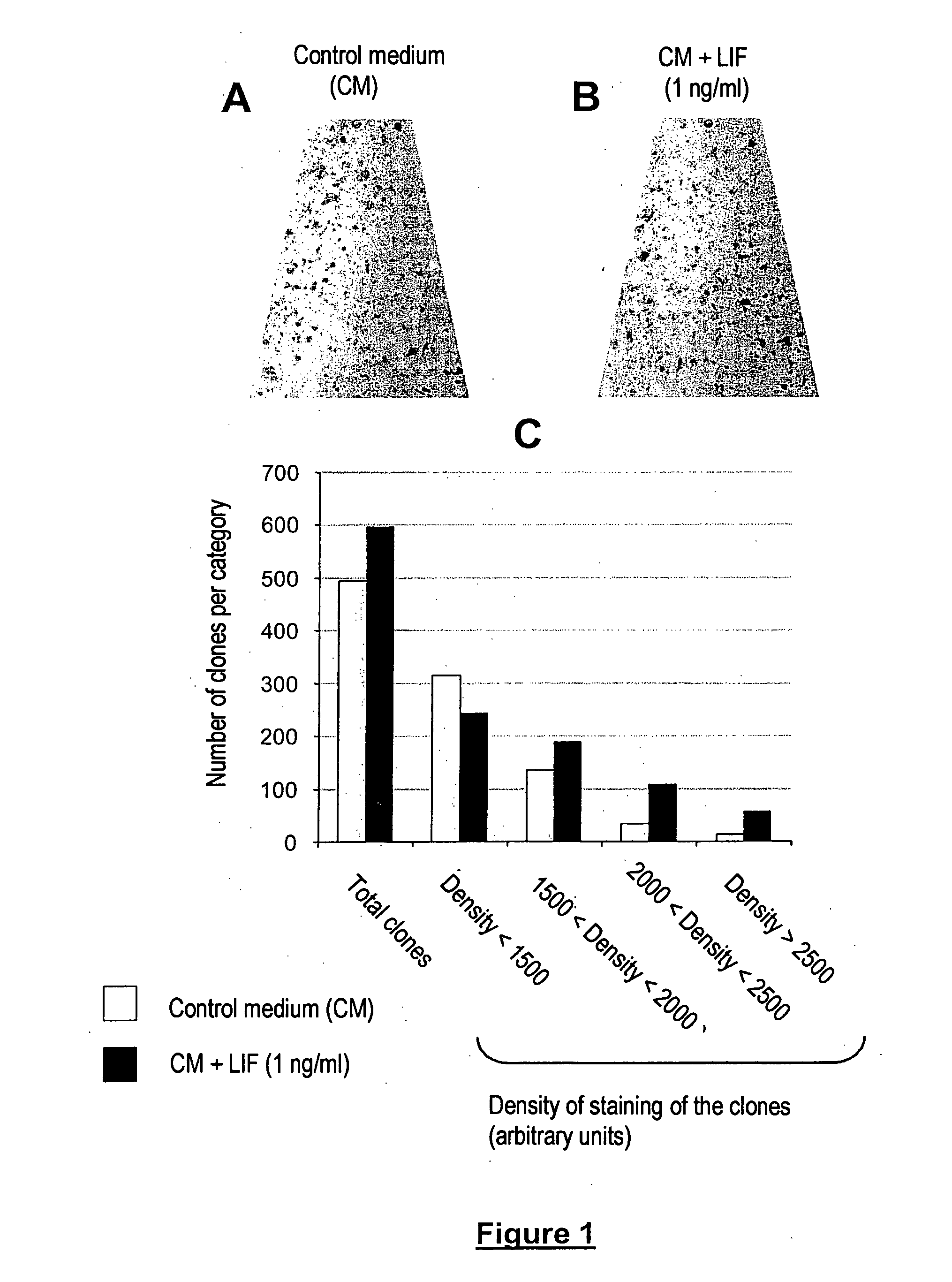Cell and tissue engineering utilizing LIF
a cell and tissue technology, applied in the field of cell and tissue engineering utilizing lif, can solve the problems of skin tissue destruction over more than 80% of the body surface, fat result, and impairment of the capacity of skin tissue to respond to “attacks” from the environment, and achieve the effect of good quality and promotion of epidermal reconstitution
- Summary
- Abstract
- Description
- Claims
- Application Information
AI Technical Summary
Benefits of technology
Problems solved by technology
Method used
Image
Examples
example 1
Undifferentiated Stem Cell and / or Epidermal Progenitor Growth Optimized in the Presence of LIF
[0178] Keratinocytes were isolated from an adult skin sample (breast plastic surgery).
[0179] After removal of the subcutaneous tissue using a scalpel, the skin sample is cut up into fragments of approximately 5 mm×5 mm, and then decontaminated by antibiotic treatment [Gentamycin (Life Technologies), 3 successive baths of 10 minutes in DMEM culture medium (Life Technologies)]. In order to allow separation of the dermis from the epidermis, the sample is then subjected to proteolytic treatment [dispase (Boehringer, Roche Diagnostics)+trypsin (Gibco, Invitrogen) overnight at 4° C.]. The epidermis is then separated from the dermis by dissection. The epidermal fragments separated from the dermal tissue are placed in a solution of 0.05% trypsin-0.02% EDTA (Gibco, Invitrogen) (15 minutes at 37° C.). The preparation is stirred periodically in order to promote dissociation of the cells. The effect ...
example 2
Positive Effect of LIF on Epidermal Reconstitution
[0188] Ground material from 3T3 fibroblasts promotes epidermal reconstitution from stem cells and / or epidermal progenitors cultured in vitro and frozen. The reconstructed epidermis is of good quality: it exhibits cellular organization and stratification similar to those of a natural epidermis (FIG. 2A).
[0189] In order to test the hypothesis that LIF is involved in this property, the LIF was depleted by immunoprecipitation and then the activity of the LIF-free ground material was compared with that of the non-depleted ground material.
[0190] The LIF-depletion of the ground 3T3 material is carried out using a polyclonal antibody produced in rabbits (anti-LIF Ab, Santa Cruz, ref. SC-20087). The ground 3T3 material is incubated with the anti-LIF Ab in excess at 4° C. for several hours in order to ensure correct binding of the LIF to the Ab. The free and LIF-bound Ab is then “trapped” by adding sepharose beads onto which proteins G have...
example 3
Preparation of an Epidermis Equivalent and / or Skin Equivalent
[0203] Unless otherwise indicated, all the media and buffers used in the examples are described in Bell el al., 1979 (Proc. Natl. Acad. Sci. USA, 76: 1274-1278, 1979), Asselineau and Prunieras, 1984 (Br. J. Dermatol., 111: 219-222, 1984) or Asselineau et al., 1987 (Models in dermato., Vol. III, Ed. Lowe & Maibach, 1-7, 1987).
[0204] The dermis supports or dermis equivalents are prepared as described in Asselineau et al., 1985 and 1987 (Exp. Cell. Res., 159: 536-539, 1985; Models in dermatology, Vol. 3, pp 1-7, 1987) in the following proportions:
MEM medium (1.76X)45%Foetal calf serum: 9%NaOH (0.1N): 5%Acetic acid (1 / 1000): 4%Collagen:26%Fibroblasts:11%
[0205] The collagen used is type I collagen (commercial solution), but type IlI or IV collagen can also be used. It is extracted from rat tails or from calf skin by acid hydrolysis, and conserved in acidic medium at +4° C.; it polymerizes naturally by reheating to 37° C. an...
PUM
 Login to View More
Login to View More Abstract
Description
Claims
Application Information
 Login to View More
Login to View More - R&D
- Intellectual Property
- Life Sciences
- Materials
- Tech Scout
- Unparalleled Data Quality
- Higher Quality Content
- 60% Fewer Hallucinations
Browse by: Latest US Patents, China's latest patents, Technical Efficacy Thesaurus, Application Domain, Technology Topic, Popular Technical Reports.
© 2025 PatSnap. All rights reserved.Legal|Privacy policy|Modern Slavery Act Transparency Statement|Sitemap|About US| Contact US: help@patsnap.com



